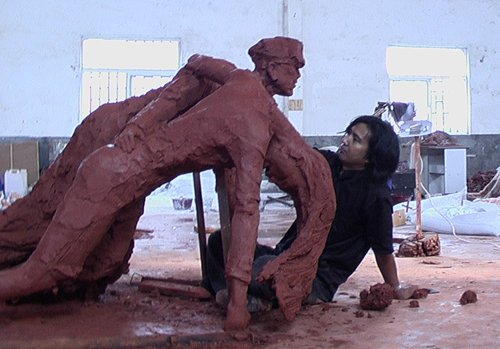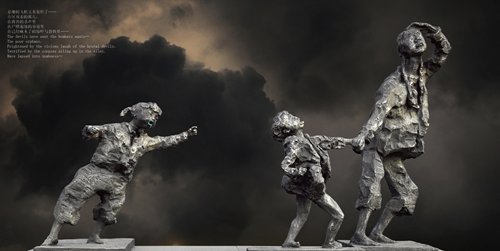
Wu Weishan works on a sculpture. Photo: Courtesy of Yangzi

Fleeing from Calamity by Wu Weishan Photo: Courtesy of Yangzi
Wednesday marked the 80th anniversary of the Nanjing Massacre, an episode of brutal violence during which invading Japanese troops killed more than 300,000 Chinese civilians and soldiers in Nanjing, East China's Jiangsu Province, over a period of six weeks.
Over the years numerous artists have used their art to memorialize the massacre and ensure that its victims are not forgotten.
Internationally renowned sculptor Wu Weishan is one of these artists. Beginning in 2005, Wu made his first series of sculptures depicting the pain and anguish surrounding this horrific event. Returning to this sad moment in history over the years, Wu has worked hard to raise awareness about the massacre through his artworks.
In 2007, several of his sculptures were placed outside the entrance of the Memorial Hall of the Victims in Nanjing Massacre by Japanese Invaders located in Nanjing. Since then, they have stood as a stark reminder of the horrors of war.
Destroyed Family is one of the most striking sculptures. Sitting right at the entrance to the hall, the 11.5-meter work depicts a mother crying out in desperation as she cradles her dead child in her arms. According to the artist, the woman represents all the Chinese mothers who lost their children during the war, but also symbolizes China, whose child, Nanjing, was devastated by Japanese invaders.
The artwork that Wu says he finds most touching is The Last Drop of Milk, which depicts a baby sucking milk from his mother's corpse.
"The sculpture is based on the account of Chang Zhiqiang, a survivor of the Nanjing Massacre. He watched as his mother and three brothers were stabbed to death by Japanese soldiers. Before leaving them, the young boy placed his youngest brother, who was still an infant, against his mother's breast so the child could be with his mother," Wu said.
The Last Drop of Milk belongs to the series Fleeing from Calamity, a group of sculptures located on pedestals throughout a small pool of water.
Also near the entrance to the exhibition hall is Screams of the Souls of the Dead. The huge triangular work is divided into two pieces with a space in the middle that acts like a sort of gate. The taller of the two pieces features a figure pointing toward the sky as he lets out a howl, while the other depicts a group of tied up people who are about to be killed.
Behind all these sculptures is the largest of Wu's works: a eight-meter high wall that stretches some 120 meters in length. Carvings along the base of one side of the wall depict the Yellow River and brave Chinese soldiers, while the other side of the wall shows triumphant Chinese soldiers crossing the Yangtze River as they return from battle. The entire work is topped off by a single statue of a Chinese solider sounding a triumphant battle call standing in front of the wall.
Famous Chinese architect Wu Liangyong praised the works in a speech made during a ceremony commemorating the 70th anniversary of the Nanjing Massacre: "This series exposes the misery of humanity to all without any extra embellishment. It depicts a time when our people suffered and struggled against death. They are epic works of art."


